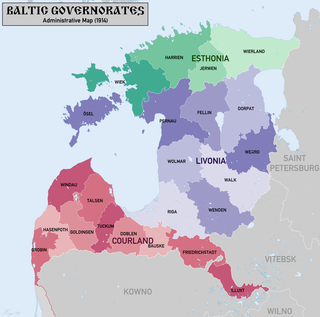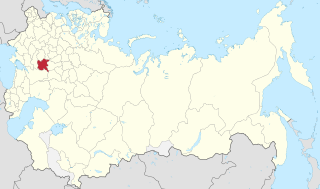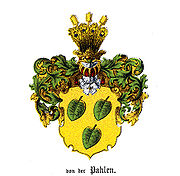
The House of Tolstoy, or Tolstoi, is a family of Russian gentry that acceded to the high aristocracy of the Russian Empire. The name Tolstoy is itself derived from the Russian adjective tolstyj. They are the descendants of Andrey Kharitonovich Tolstoy, who moved from Chernigov to Moscow and served under Vasily II of Moscow in the 15th century. The "wild Tolstoys", as they were known in the high society of Imperial Russia, have left a lasting legacy in Russian politics, military history, literature, and fine arts. The most famous member of the family is the author Leo Tolstoy.

The Order of Saint Andrew the Apostle the First-Called is the highest order conferred by both the Russian Imperial Family and by the Russian Federation . Established as the first and highest order of chivalry of the Russian Tsardom and the Russian Empire in 1698, it was removed from the honours system under the USSR before being re-established as the top Russian civil and military order in 1998.

The Wrangel family is a Baltic German noble family with branches in several countries. Members of the family have also been part of the Swedish, Russian, Spanish, and Prussian nobility.

The Baltic Governorates, originally the Ostsee Governorates, was a collective name for the administrative units of the Russian Empire set up in the territories of Swedish Estonia, Swedish Livonia (1721) and, afterwards, of the Duchy of Courland and Semigallia (1795).

Count Nikita Petrovich Panin was an Imperial Russian diplomat, vice-chancellor, and (acting) State Chancellor and Foreign Minister of Russia. He was a nephew of Count Nikita Ivanovich Panin, son of Petr Ivanovich Panin, son-in-law of Count Vladimir Orlov.

Peter Ludwig Graf von der Pahlen was a Russian courtier and general of Baltic German stock, who played a pivotal role in the assassination of Emperor Paul I of Russia in 1801. He became a general in the Imperial Russian Army in 1798, a count in 1799, and served as Military Governor of Saint Petersburg from 1798 to 1801.

The Baltic German nobility was a privileged social class in the territories of modern-day Estonia and Latvia. It existed continuously from the Northern Crusades and the medieval foundation of Terra Mariana.
Friedrich Alexander Graf von der Pahlen was a Baltic German diplomat and administrator.

Courland Governorate, also known as the Province of Courland or Governorate of Kurland, and known from 1795 to 1796 as the Viceroyalty of Courland, was an administrative-territorial unit (guberniya) and one of the Baltic governorates of the Russian Empire. Its area roughly corresponded to Kurzeme, Zemgale and Sēlija of modern-day Latvia.
The Imperial Russian Army in June 1812 consisted of three main armies and other military formations. The Commander in Chief of the Army was Emperor Alexander I.

The House Clodt von Jürgensburg was a Russian noble family of Baltic German origin, whose members were prominent soldiers and artists.
The governor-general of the Baltic provinces or governor-general of Estonia, Livonia, and Courland was the military commander of the Riga Military District and the highest administrator of the Baltic governorates of Estonia, Livonia and Courland sporadically under Russian rule in the 19th century.

Pskov Governorate was an administrative-territorial unit (guberniya) of the Russian Empire and the Russian SFSR, which existed in 1772–1777 and 1796–1927. Its seat was located in Opochka between 1772 and 1776, and in Pskov after 1776. The governorate was located in the west of the Russian Empire and bordered Saint Petersburg Governorate in the north, Novgorod Governorate in the northeast, Tver Governorate in the east, Smolensk Governorate in the southeast, Belarusian Governorate in the south, and Governorate of Livonia in the west.

Voronezh Governorate was an administrative-territorial unit (guberniya) of the Tsardom of Russia, the Russian Empire, and the Russian SFSR, which existed from 1708 to 1779 and again from 1796 to 1928. Its capital was located in Voronezh since 1725.

Peter Johann Christoph Graf von der Pahlen was a Baltic German aristocrat and a general of the Imperial Russian Army.
The 1st Don Cossack Division was a Don Cossack cavalry division of the Russian Imperial Army. It was part of the 19th Army Corps in the Warsaw Military District.

The Koskullfamily, also written as Koschkull, is a wealthy aristocratic family of Livonian and German origin, famous for their extensive lands and manors. The family is descended from the first King of Livonia and officially established in Livonia as Koskele in 1302. The family spread to Estonia, Courland and Poland in the 15th century, Sweden and Finland in the 17th century, and Prussia and Russia in the 18th century. Several branches of the family still exist today. The Koskulls are believed to be related to the von der Pahlen family.

The Life Guard Horse Regiment was a cavalry regiment of the Imperial guard of Russian Empire. The regiment was founded in the reign of Peter the Great and was disbanded after the October Revolution in 1917. Its annual feast day was 25 March.

The Fan-der-Flit family is a Russian noble family.

















